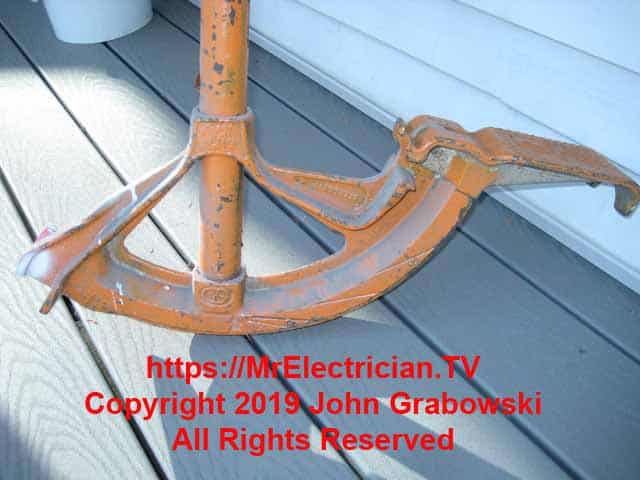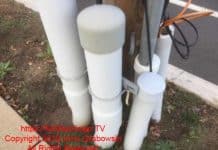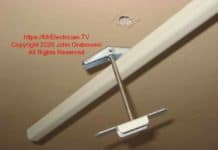Dear Mr. Electrician: What are inch-and-a-quarter conduit sizes?
Answer: The dimensions for various types of 1-1/4″ electrical conduits are below. One Inch and a Quarter (1-1/4″) is the trade size, not the actual dimension of the electrical conduit. Thirty-five (35) is the metric designator, not the exact dimension in millimeters.
NOTE: Some text links below go to applicable products on Amazon. As an Amazon Associate, I earn from qualifying purchases. Using my links helps to keep this website FREE.
The information was derived from several sources and should not be considered precise. Electrical conduit dimensions may vary slightly between manufacturers.
Use a 1-3/4″ (44mm) hole saw for inch-and-a-quarter (1.25″) electrical conduit fittings.
You can see all hole saw sizes for electrical conduits on my chart here.
Table of Contents:
- EMT
- Rigid Metal Conduit
- Intermediate Metal Conduit
- Flexible Metal Conduit
- Sealtight
- PVC 40
- PVC 80
- Smurf
- LFNC
- Fiberglass
- HDPE
- Tap and Die Sizes
- Other Conduit Sizes
- Links
METAL ELECTRICAL CONDUIT
1-1/4″ Electrical Metallic Tubing (EMT or Thinwall) is a smooth, lightweight galvanized metal conduit with an inside diameter of 1.380″ or 35.05mm. The outside diameter is 1.510″ or 38.35mm. The wall thickness of 1-1/4″ EMT is 0.065″ or 1.65mm.
100 feet of 1-1/4″ EMT weighs approximately 101 pounds or 45.8 kilograms. The conduit fittings require a 1 3/4″ hole. A tap needs a 1-1/2″ hole. Threads per inch for the fittings is 11.5 NPT.
1-1/4″ Rigid Metal Conduit (RMC) is a heavy-weight conduit with a galvanized finish throughout. It has factory threads 11.5 NPT with a 3/4″ per foot taper. 100′ of 1-1/4″ RMC weighs approximately 218 pounds or 98.9 kilograms.
Inch-and-a-quarter RMC has an inside diameter of 1.380″ or 35.05mm. It has an outside diameter of 1.660″ or 42.2mm. The wall thickness is .133″ or 3.40mm. 1-1/4″ Rigid requires a 1-3/4″ hole for the conduit and fittings. A tap needs a 1-1/2″ hole.
1-1/4″ Intermediate Metal Conduit (IMC) is a lighter-weight version of RMC. It has a galvanized finish inside and out and can be used in many of the same environments as RMC. It has factory threads with a 3/4″ per foot taper and 11.5 threads per inch NPT. It also utilizes the same couplings and fittings as RMC.
100 feet of 1-1/4″ IMC weighs approximately 158 pounds or 71.7 kilograms. 1-1/4″ IMC has an inside diameter of 1.468″ or 36.8mm. It has an outside diameter of 1.638″ or 41.6mm. The wall thickness is .095″ or 2.41mm.

The 1-1/4″ EMT bender above can also be used for one-inch rigid and one-inch aluminum electrical conduit. There are formulas that electricians use to calculate the degree angle and length for elbows, offsets, and saddle bends. The electrical conduit bender has a long handle not shown in this photo.
1-1/4″ Flexible Metal Conduit (FMC or Greenfield) is a galvanized finished flexible metal electrical conduit composed of a continuously formed interlocking metal strip.
100 feet of 1-1/4″ Reduced Wall Steel Greenfield weighs approximately 65 pounds (29.48 kilograms). Reduced Wall 1-1/4″ Aluminum FMC weighs 24 pounds or 10.88 kilograms.
1-1/4″ FMC has a minimum inside diameter of 1.250″ or 31.75mm and a maximum inside diameter of 1.300″ or 33.02mm. It has a minimum outside diameter of 1.550″ or 39.37mm and a maximum outside diameter of 1.630″ or 41.40mm. The minimum bending radius is 8 inches or 203.2mm. 1-1/4″ Flex requires a 1-3/4″ hole for the conduit fittings. A tap needs a 1-1/2″ hole. Threads per inch for the fittings is 11.5 NPT.
1-1/4″ Liquidtight Flexible Metal Conduit (LFMC or Sealtight) is a flexible metal conduit with a non-metallic, non-conductive outer jacket that makes it suitable for use in wet locations. 100 feet of 1-1/4″ Sealtight weighs 100 pounds or 45.35 kilograms.
Inch and a quarter Sealtight has an inside minimum diameter of 1.380″ or 35.05mm and a maximum inside diameter of 1.410″ or 35.814mm. It has a minimum outside diameter of 1.630″ or 41.40mm and a maximum outside diameter of 1.660″ or 42.16mm. The minimum bending radius is 8 inches (152.4mm). Fittings require a 1-3/4″ hole. A tap needs a 1-1/2″ hole. Threads per inch for the fittings is 11.5 NPT.
NON-METALLIC ELECTRICAL CONDUIT
1-1/4″ Rigid Polyvinyl Chloride Conduit (PVC) schedule 40 is a nonmetallic, non-conductive electrical conduit that is good to use indoors, outdoors, or underground. It has some flexibility with an inside diameter of 1.380″ or 35.05mm. It has an outside diameter of 1.660″ or 42.16mm. The wall thickness is .140″ or 3.556mm.
1-1/4″ Schedule 40 weighs 46 pounds per 100 feet (20.86 kilograms). 1-1/4″ PVC requires a 1-3/4″ hole for the conduit fittings. A tap needs a 1-1/2″ hole. Threads per inch for the fittings is 11.5 NPT.
1-1/4″ Rigid Polyvinyl Chloride Conduit (PVC) schedule 80 is a nonmetallic, non-conductive electrical conduit that is good to use indoors, outdoors, or underground. It has limited flexibility. Schedule 80 has an inside diameter of 1.278″ or 32.46mm. It has an outside diameter of 1.660″ or 42.16mm. The wall thickness is .191″ or 4.8514mm.
1-1/4″ Schedule 80 weighs 60 pounds per 100 feet or 27.21 kilograms. 1-1/4″ PVC requires a 1-3/4″” hole for the conduit fittings. A tap needs a 1-1/2″ hole. Threads per inch for the fittings is 11.5 NPT.
1-1/4″ Electrical Nonmetallic Tubing (ENT or Smurf) is a nonmetallic, non-conductive flexible conduit with an inside diameter of 1.402″ or 35.61mm. It weighs 19 pounds per 100 feet or 8.62 kilograms.
1-1/4″ ENT has an outside diameter of 1.660″ or 42.16mm. The minimum bend radius is 7 inches or 177.8mm. 1-1/4″ fittings require a 1-3/4″ hole. A tap needs a 1-1/2″ hole. Threads per inch for the fittings is 11.5 NPT
1-1/4″ Liquidtight Flexible Nonmetallic Conduit (LFNC or CarFlex) is a nonmetallic conduit suitable for wet conditions. 100′ of 1-1/4″ Carflex weighs 35 pounds or 15.88 kilograms. It has an inside minimum diameter of 1.380″ or 35.05mm and a maximum inside diameter of 1.410″ or 35.814mm.
It has a minimum outside diameter of 1.630″ or 41.40mm and a maximum outside diameter of 1.660″ or 42.16mm. The minimum bending radius is 8 inches or 203.2mm. The conduit fittings require a 1-3/4″ hole. A tap needs a 1-1/2″ hole. Threads per inch for the fittings is 11.5 NPT.
1-1/4″ Reinforced Thermosetting Resin Conduit (RTRC or Fiberglass) is a nonmetallic conduit suitable for many conditions. It has an inside diameter of 1.520″ or 38.61mm. The outside diameter is 1.660″ or 42.16mm. The conduit wall thickness is .070″ or 1.778mm.
One hundred feet of inch-and-a-quarter SW RTRC weighs 23 pounds. The conduit fittings require a 1-3/4″ hole. A tap needs a 1-1/2″ hole. Threads per inch for the fittings is 11.5 NPT.
1-1/4″ High-Density Polyethylene (HDPE) is a non-metallic flexible conduit in long reel lengths to reduce joints and installation time. It has an outside diameter of 1.660″ or 42.16mm.
Type SDR-9 has an inside diameter of 1.270″ or 32.26mm. 100 feet of 1-1/4″ HDPE weighs 37 pounds. The wall thickness is .184″ or 4.67mm.
TAP AND DIE SIZES
All inch-and-a-quarter (1-1/4″) (35mm) conduit and fittings require an inch and three-quarter 1-3/4″ opening into an electrical box. The hole can be made with a hole saw or a knockout punch.
A tap for one inch and a quarter (1-1/4″) conduit or conduit fittings requires a 1-1/2″ hole. The threads per inch is 11.5 National Pipe Taper (NPT) with a 3/4″ per foot taper.
However, there are NPS (National Pipe Straight) threads in some cases, such as on some fittings. NPS threads require a 1-31/64″ hole for an inch and a quarter NPS conduit tap.
My rule of thumb for determining if a conduit or electrical fitting is NPS or NPT is to notice if the fitting came with a locknut. If it came with a locknut, it is not meant for threading into a pipe and is an NPS thread. If you tried to screw one of these into an NPT fitting, such as a threaded condulet, it would not thread all of the ways due to the condulet having a tapered thread (NPT).
The standard length for most conduits is ten feet (10′) or 3.048 meters. Twenty-foot (20′) (6.096 meters) lengths of metal conduit are available but not always in stock. PVC conduit is available in ten-foot (10′) and, in some sizes, twenty-foot (20′) lengths. RTRC mostly comes in twenty-foot (20′) lengths. The flexible conduits come in coils and reels of various lengths depending on the trade size. Some electrical supply companies will cut the flexible conduits to length.
See my post describing various electrical conduit types.

MORE ELECTRICAL CONDUIT DIMENSIONS
1 1/2″ (41) 2″ (53) 2 1/2″ (63)
For more conduit code details and conduit fill, see Chapter 9, Tables 1, 4, 5, and 5A.
See the tables in Informative Annex C in the back of the National Electrical Code (NFPA 70) for the allowable number of wires in each size conduit.
ELECTRICAL CONDUIT MANUFACTURERS
Aluminum and Steel Conduit Products – https://www.westerntube.com/
Fiberglass Conduit Products – https://championfiberglass.com/
PVC Conduit products – https://www.cantexinc.com/
Steel Conduit Products – https://www.alliedeg.us/
Here is an example of a Tesla Wall Connector Electric Vehicle Charger installed using LFNC conduit.
To help keep this website FREE, please use this Amazon link for your purchases. As an Amazon Associate, I earn from qualifying purchases.
Click for a FREE copy of my book “Almost Everything You Need To Know To Repair a Bathroom Exhaust Fan In Your Home.”
Get your required “Emergency Disconnect, Service Disconnect” labels and stickers to satisfy the 2023 National Electrical Code requirements in article 230.85(E)(1) and (2) by going to my Redbubble Shop here.
Visit my Link Tree for all of my social media links and merchandise.










